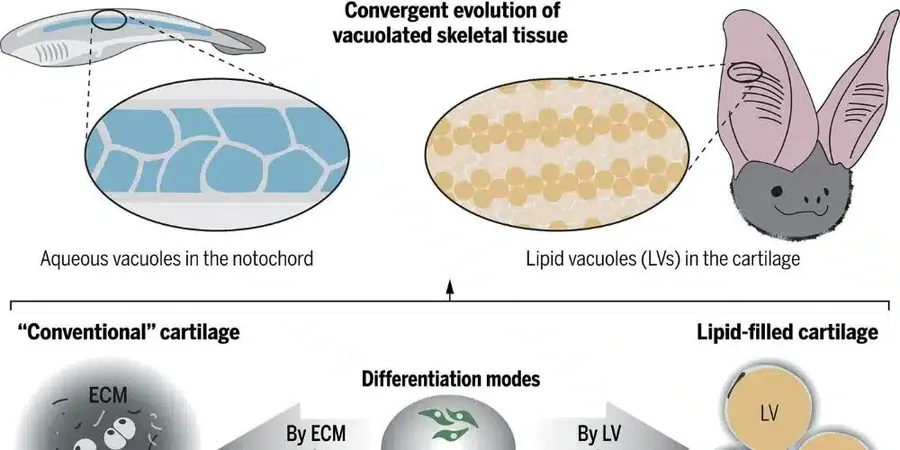
Groundbreaking Discovery: Lipocartilage Unveiled as a New Type of Tissue!
2025-01-13
Author: Nur
Groundbreaking Discovery: Lipocartilage Unveiled as a New Type of Tissue!
In a stunning revelation, scientists have uncovered a novel form of cartilage, distinct from the three commonly recognized types. Dubbed "lipocartilage," this extraordinary tissue boasts a unique composition that sets it apart from traditional cartilage. Unlike conventional cartilage, which typically features thick fiber matrices, lipocartilage is characterized by balloon-like cells filled with oils. These cells are uniformly packed, resulting in a structure that is both elastic and resilient. Researchers have identified this tissue in areas like the ear and nose, where it adeptly balances flexibility with durability. This exciting discovery paves the way for a new understanding of cartilage and its vital functions in the human body.
Study Reveals Lipocartilage's Remarkable Properties
The groundbreaking findings on lipocartilage were unveiled in the prestigious journal *Science*. Researchers initially stumbled upon this unique tissue during a detailed investigation of mouse ear tissue. Remarkably, lipocartilage shares similarities with fat but possesses a distinct fibrous architecture. Notably, lipocartilage maintains its size regardless of dietary changes, a trait that differentiates it from adipose cells, which can grow or shrink with changes in caloric intake. Even more striking is the absence of enzymes necessary for fat breakdown and the transporters needed to handle dietary fats, ensuring the structural integrity of lipocartilage remains uncompromised.
Maksim Plikus, a leading professor at the University of California, Irvine, provided compelling insights into the functionality of lipocartilage. He likened it to "Bubble Wrap," underscoring its significant role in enhancing the acoustic properties of the outer ear. By ensuring stable sound wave transmission, lipocartilage is critical to our ability to hear clearly. This discovery raises intriguing questions about the functionality of lipocartilage in other parts of the body.
Rediscovering a Historical Tissue
Interestingly, lipocartilage is not a completely new concept in science. The tissue was first documented in the 1850s by renowned biologist Franz von Leydig, who noted its resemblance to adipose tissue. However, it faded from scientific discourse in the late 20th century. The latest research has revived interest in lipocartilage, showcasing its distinct genetic and molecular profile and supporting its classification as a potential fourth type of cartilage.
Despite the enthusiasm surrounding this discovery, some experts urge caution. Shouan Zhu from Ohio University has expressed skepticism, proposing that lipocartilage might be a subtype of elastic cartilage rather than an entirely new category. This ongoing dialogue highlights the complexity of cartilage classification and the pressing need for further investigation to illuminate the true nature of lipocartilage.
Implications and Future Research Directions
The implications of lipocartilage’s discovery extend far beyond mere anatomical curiosities. Found in human fetal tissues and across various mammals, but not in nonmammals, lipocartilage raises fascinating questions about its evolutionary roots and function in diverse species. Future studies will delve into its regenerative potential and explore how this tissue copes with high fat content without adverse effects.
According to researchers Viviana Hermosilla Aguayo and Dr. Licia Selleri from the University of California, San Francisco, this discovery could necessitate significant updates to existing anatomical and histological literature. As scientists continue to explore lipocartilage, they are eager to unravel its functions and investigate potential applications in medicine, promising further advancement in our understanding of this remarkable tissue.
Stay tuned as new findings emerge in the fascinating world of anatomy, where every discovery could change the way we view the human body!

 Brasil (PT)
Brasil (PT)
 Canada (EN)
Canada (EN)
 Chile (ES)
Chile (ES)
 Česko (CS)
Česko (CS)
 대한민국 (KO)
대한민국 (KO)
 España (ES)
España (ES)
 France (FR)
France (FR)
 Hong Kong (EN)
Hong Kong (EN)
 Italia (IT)
Italia (IT)
 日本 (JA)
日本 (JA)
 Magyarország (HU)
Magyarország (HU)
 Norge (NO)
Norge (NO)
 Polska (PL)
Polska (PL)
 Schweiz (DE)
Schweiz (DE)
 Singapore (EN)
Singapore (EN)
 Sverige (SV)
Sverige (SV)
 Suomi (FI)
Suomi (FI)
 Türkiye (TR)
Türkiye (TR)
 الإمارات العربية المتحدة (AR)
الإمارات العربية المتحدة (AR)